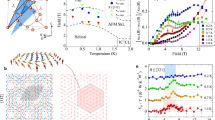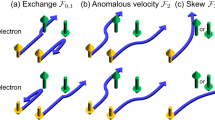Abstract
In this paper, we focus on the connection between spin Hall effect and spin force. Here we investigate that the spin force due to spin-orbit coupling, which, in two-dimensional system, is equivalent to forces of Hirsch and Chudnovsky besides constant factors 3 and \(\frac{3}{2}\) respectively, is a part of classic Anandan force, and that the spin Hall effect is an anomalous Hall effect. Furthermore, we develop the method of AC phase to derive the expression for the spin force, and note that the most basic spin Hall effect indeed originate from the AC phase and is therefore an intrinsic quantum mechanical property of spin. This method differs from approach of Berry phase in the study of anomalous Hall effect , which is the intrinsic property of the perfect crystal. On the other hand, we use an elegant skill to show that the Chudnovsky-Drude model is reasonable. Here we have improved the theoretical values of spin Hall conductivity of Chudnovsky. Compared to the theoretical values of spin Hall conductivity in the Chudnovsky-Drude model, ours are in better agreement with experimentation. Finally, we discuss the relation between spin Hall effect and fractional statistics.
Similar content being viewed by others
References
H.-A. Engel, E.I. Rashba, B.I. Halperin, arXiv: cond-mat/0603306
In this paper we only focus on the intrinsic Hall effect, with all extrinsic mechanisms of Hall effect (such as skew scattering and side-jump) disregarded. We will use the expression for the resistivity ρH to distinguish the ordinary and anomalous Hall effect. The ordinary Hall effect means the resistivity reads ρH = R 0 B, and the anomalous Hall effect the resistivity ρH = R 0 B + 4πR s M, where B the applied magnetic field and M the magnetization per unit volume
E.M. Chudnovsky, Phys. Rev. Lett. 99, 206601 (2007)
E.M. Chudnovsky, Phys. Rev. Lett. 100, 199704 (2008)
B.A. Bernevig, S.C. Zhang, Phys. Rev. Lett. 96, 106802 (2006), arXiv: cond-mat/0504147
J. Sinova, et al., Phys. Rev. Lett. 92, 126603 (2004), arXiv: cond-mat/0307663
S.O. Valenzuela, M. Tinkham, Nature 442, 176 (2006)
Y. Aharonov, A. Casher, Phys. Rev. Lett. 53, 319 (1984)
J. Anandan, Phys. Lett. A 138, 347 (1989)
J. Anandan, Phys. Rev. Lett. 85, 1354 (2000)
A.S. Goldhaber, Phys. Rev. Lett. 62, 482 (1989)
J. Fröhlich, U.M. Studer, Rev. Mod. Phys. 65, 733 (1993)
J.E. Hirsch, Phys. Rev. B 60, 14787 (1999)
J.E. Hirsch, Phys. Rev. Lett. 83, 1834 (1999)
J.E. Hirsch, arXiv: 0709.1280
M. Schulz, S. Trimper, Phys. Lett. A 372, 5905 (2008)
V.Y. Kravchenko, Phys. Rev. Lett. 100, 199703 (2008)
V.Y. Kravchenko, arXiv: 0805, 3724
F. Wilczek, Phys. Rev. Lett. 49, 957 (1982)
X.G. He, B.H.J. McKellar, Phys. Lett. B 256, 250(1991)
X.G. He, B.H.J. McKellar, Phys. Lett. B 264, 129(1991)
L.L. Foldy, Phys. Rev. 87, 688 (1952)
C.N. Yang, R.L. Mills, Phys. Rev. 96, 191 (1954)
P.Q. Jin et al., J. Phys. A: Math. Gen. 39, 7115 (2006), arXiv: cond-mat/0502231
S.Q. Shen, Phys. Rev. Lett. 95, 187203 (2005)
B. Zhou et al., Phys. Rev. B 73, 165303 (2006)
A. Stern, Phys. Rev. Lett. 68, 1022 (1992)
C.M. Ryu, Phys. Rev. Lett. 76, 968 (1996)
A.V. Balatsky, B.L. Altshuler, Phys. Rev. Lett. 70, 1678 (1993)
M.C. Chang, Q. Niu, Phys. Rev. B 53, 7010 (1996)
N. Nagaosa et al., arXiv: cond-mat/0904.4154
M.V. Berry, Proc. R. Soc. London Ser. A 392, 45 (1984)
T.H. Boyer, Phys. Rev. A 36, 5083 (1987)
T. Lee, C.M. Ryu, Phys. Lett. A 194, 310 (1994)
The more general case for singularity function f n (x) has property that \( \nabla \left( {\mathop {\lim }\limits_{n \to \infty } f_n (x)} \right) \ne \mathop {\lim }\limits_{n \to \infty } \left( {\nabla f_n (x)} \right) \) and \( \nabla \left( {\sum\limits_{n = 1}^\infty {f_n (x)} } \right) \ne \sum\limits_{n = 1}^\infty {\left( {\nabla f_n (x)} \right)} \)
F. Wilczek, A. Zee, Phys. Rev. Lett. 52, 2111 (1984); H.Z. Li, Phys. Rev. Lett. 58, 539 (1987)
Sun Chang-Pu, Ge Mo-Lin, Science in China A 05, 478 (1990)
Y. Wang et al., Phys. Rev. Lett. 96, 066601 (2006)
R. Shen et al., Phys. Rev. B 74, 125313 (2006)
A.V. Rodina, A.Y. Alekseev, Phys. Rev. B 78, 115304 (2008)
N. Fumita et al., Phys. Rev. D 49, 4277 (1994)
Author information
Authors and Affiliations
Corresponding author
Rights and permissions
About this article
Cite this article
Tao, Y. Spin hall effect associated with SU(2) gauge field. Eur. Phys. J. B 73, 125–132 (2010). https://doi.org/10.1140/epjb/e2009-00413-y
Received:
Revised:
Published:
Issue Date:
DOI: https://doi.org/10.1140/epjb/e2009-00413-y




